Siete qui:
- Home
- The MODO Museum
- Art and artists
- Papal Palace Collection. First Floor. Room of the Meraviglie
Papal Palace Collection. First Floor. Room of the Meraviglie
Entrance
Sienese-Umbrian sculptor and 'Maestro Sottile' (Lorenzo Maitani?)
Madonna and Child Enthroned and six angels
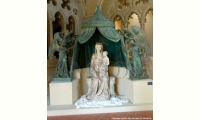 Early 14th century (Madonna), 1325 (angels and baldachin)
Early 14th century (Madonna), 1325 (angels and baldachin)
Marble, bronze, polychromy, gold and glass paste
Provenance: Orvieto, cathedral, over the main door of the facade
While the sculptor of the early fourteenth-century Madonna and Child remains unknown, the right forearm and both arms of the Child are much later restorations. The canopy and six angels were cast in 1325 in bronze in the lost wax process and the inner supports are still visible. Traces of the original colors and gilding have survived, in particular on the shoes and wings of the angels. At least two of the angels were decorated in 1330.The decorations along the edges of the baldachin are in glass paste. The group, although with a few differences, goes back to the first project for the facade of the cathedral.
An accumulation of pigeon droppings, dirt and corrosion made the removal of this group from its original site in the lunette over the principal entrance to the Cathedral imperative. Restoration began in 1982 and a copy replaces the figures on the façade of the Cathedral.
Maestro dei Corali di san Lore
nzo
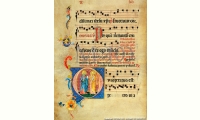 Antiphonary
Antiphonary
First half fourteenth century
Vellum in littera textualis, bound in leather-covered boards
h. cm. 51 x l. cm 36 x p. cm. 15.5
foglio cm.52 x 39
In a relatively good state of conservation, this antiphonary or book containing choral parts of the Divine Office, can be assigned to one of the leading miniature artists in Perugia, conventionally indicated as Maestro dei Corali di San Lorenzo.
This anonymous artist, with a complex and elegant culture, merged traits of transalpine art, evident in the way in which the backgrounds of the figures have been handled, with the traditional style of late thirteenth-, early fourteenth-century Perugia miniatures.
There seem to be close ties of this illuminator with the sculptures on the piers of the Cathedral of Orvieto, in particular with the reliefs on the inner piers of the facade. In subsequent miniatures those done for the Cathedral of Perugia, the ties are more evident with the reliefs of the so-called maestro Sottile, which might mean that the Antiphonary of Orvieto is the earliest work done by this great anonymous illuminator.
Ugolino di Vieri and Viva di Lando
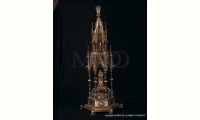 Reliquary of the skull of Saint Sabinus
Reliquary of the skull of Saint Sabinus
1340-45
Cast bronze, embossed, engraved, chiseled, gilded. Translucent enamel on silver; h. 105 cm. including the angel
Inscriptions: (below the Madonna and Child): UGHOLINUS ET VIVA D[E] SENIS FECIERU[N]T ISTUM TABERNACULU[M]
Provenance: Orvieto, church of San Giovenale
In the Opera since 1845
In 1845 the reliquary, or container for relics venerated for their healing powers and considered "more valuable than precious stones", was sold to the Opera by the parish priest of the church of San Giovenale. Whether it was made for that church or acquired later is still a moot question. Unlike the usual fourteenth-century skull reliquaries for bishop saints in the shape of a bust, here the saint's cranium was housed in the cupola set on the hexagonal base on which the Madonna and Child are standing. Note the affectionate gesture of the Child reaching up to touch His mother's face. St. Sabinus, bishop of Canosa di Puglia, who died in 566, is shown in the chamber on the second level and six stories of his life are depicted in translucent enamel on the base. The angel at the top was added between 1855 and 1896 to replace an earlier figure, perhaps a Savior.
Ugolino di Vieri, one of the two Sienese goldsmiths who signed the work, is best known for the famous reliquary of the Corporal (altar cloth), dated 1338 and signed together with no better specified 'others', currently in the Chapel of the Corporal or Miracle of Bolsena.
Lippo Vanni (?)
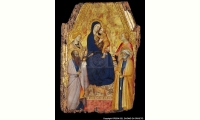 Madonna and Child Enthroned with Saints Agnes, Paul, Peter and Lucy
Madonna and Child Enthroned with Saints Agnes, Paul, Peter and Lucy
Mid-14th century
Tempera and gold on wood: 30.5 x 21.5 cm.
Provenance: Orvieto, church of San Francesco
While the tip of the panel has been cut off and the edges have also been damaged by woodworms, the figures themselves are fairly intact. Stylistically they reflect the two main currents of art in Siena in the first half of the 14th century. The two female saints, Agnes identified by the lamb she holds, and Lucy with her eyes on a plate, hark back to the art of Ambrogio Lorenzetti in their solidity of form and emotional depth, while the transparent glazing and gilding with punch tooling reveals the influence of Simone Martini and his stress on decorative features and courtly elegance.
Room 1
Roman artist (?)
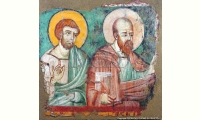 Two apostles
Two apostles
circa 1275-1285
Detached fresco; 80x82 cm.
Provenance: Orvieto (environs), abbey of Saints Severo and Martirio
Formerly identified as Severus and Martirius, titular saints of the abbey just outside Orvieto, they represent two apostles, the one on the right holding the book is Paul. Both face right and were part of a larger wall painting of Christ surrounded by the apostles. The style is close to Roman wall painting between the 1260s and 1290s. The heavy draperies and the features reveal the influence of Late Antique painting.
Arnolfo di Cambio and workshop
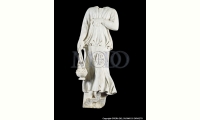 Two censing angels
Two censing angels
circa1282
Marble; h. 58 cm.
Provenance: Orvieto, San Domenico, tomb of Cardinal de Braye (?)
In the museum of the Opera del Duomo since 1913
The square holes on the back of these two headless statues might have been used to attach wings, perhaps in metal. Since the backs of the figures are roughly finished, they were meant to be seen only from the front. To judge from the pose and gestures they may have flanked a central figure. While the style suggests they might have been part of Arnolfo di Cambio's tomb for Cardinal de Braye in the church of San Domenico in Orvieto. Just where on the tomb is uncertain since the reconstruction of the monument is conjectural. They might possibly have been above, outside the architectural structure of which only the lower part was saved.
Follower of Nicola Pisano
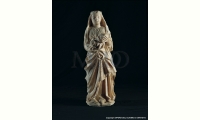 Madonna and Child
Madonna and Child
circa 1270
Marble; h. 58 cm.
In generally fair condition, with the exception of the child. Traces of color reveal that the statue was once colored, not unusual for the times. There is a monumentality to the figure despite its small size and it can be attributed to a sculptor close to Nicola Pisano, identified in the past with Lapo, one of the assistants to the maestro of the pulpit in the cathedral of Siena and creator of a new sculptural style in Italy.
Sienese sculptor
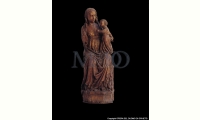 Enthroned Madonna and Child
Enthroned Madonna and Child
circa 1300
Pear wood with traces of color; h. 70 cm.
Provenance: Orvieto (environs), church of the abbey of Santi Severo e Martirio
Although considerably damaged by woodworms, including the loss of the right forearm, scant traces of the original color remain. The statue was probably originally located in a tabernacle with doors or under a baldachin. The Child holds a redbreast – allusion to His Passion – and is in a 'walking' position, a pose with French antecedents. There has been much debate regarding the identity of the sculptor and various artisans in the cathedral workshop have been proposed. The most likely is Ramo di Paganello from Siena who may also have been the draftsman of the first drawing for the facade of the cathedral, in which there is a figure very close to this one over the main portal. It has also been proposed that the artist was Umbrian.
Workshop of Andrea Pisano (?)
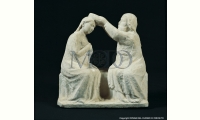 Coronation of the Virgin
Coronation of the Virgin
1347-1348 (?)
Marble; h. 34 cm.
Provenance: Orvieto, cathedral workshop
An unfinished work, it is also of interest in the marks of the various types of chisels. It might have been made in the period when Andrea Pisano was capomastro of the Orvietan workshop, between 13347 and 1348. It may have been made for an altar.
Nino Pisano
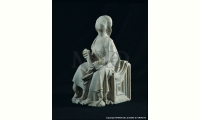 Fortitude (unfinished statue)
Fortitude (unfinished statue)
1349
Marble; h. 52 cm.
Provenance: Orvieto, cathedral workshop (?)
To judge from the position of the head the figure might have been part of a group. To be noted is that the two sides of the throne are different, since only the right side was completely visible It can be identified as Fortitude because of the column, her usual attribute. Of particular interest in this unfinished statue are the signs left by the different types of chisels.
Third master of Orvieto
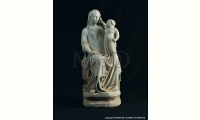 Madonna Enthroned and Child
Madonna Enthroned and Child
First two decades of the 14th century
Marble; h. 59 cm.
Sienese sculptor
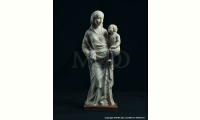 Madonna and Child
Madonna and Child
circa 1330
Marble; h. 57 cm.
Andrea and Nino Pisano
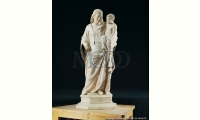 Madonna and Child with two angels
Madonna and Child with two angels
1346-1347
Marble; Madonna, h. 86 cm., the angels, 48 cm. and 52 cm.
Provenance: Orvieto, cathedral
Unlike the Madonna, the two flanking angels (not shown in this photo) no longer have their heads. They held a candelabra or a vase of flowers and two slits on their backs must have served to attach wings, perhaps in metal. Traces of gilt decoration on the clothing and blue in the inner lining of the cloaks remain. The group seems to have been made between May 1347 and April 1348 when Andrea Pisano was capomastro or master builder of the cathedral workshop. Judging from the excellent condition of the surfaces they were probably not set outside but may have been made for an altar in the cathedral. The Madonna and the left angel are attributed to Andrea, the other angel to Nino.
Orvieto maestro
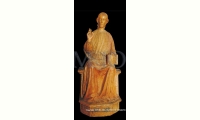 Blessing Christ
Blessing Christ
circa 1330
Pear wood, with polychromy; h. 192 cm.
Provenance: Orvieto, Congregazione di Carità
Northern French sculptor
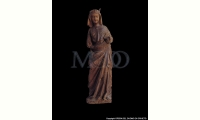 Madonna originally with a Child (now lost)
Madonna originally with a Child (now lost)
Late 13th century
Pear wood; h. 70 cm.
Provenance: Orvieto, church of Santa Lucia
The figure was originally in a tabernacle to judge from the flat back. It was reworked to transform it into Saint Lucy when it was in the church dedicated to her, transforming the lower part of the body of the Child into a lamp, which later was lost.
Sculptor from France or Lorraine
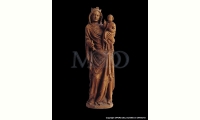 Madonna and Child
Madonna and Child
1330/1340
Wood; h. 154 cm.
Provenance: Orvieto, church of San Giovanni
Traces of the original color are still visible in the hair of both figures. Mary originally held a scepter or a flower in her right hand.
Nino and Tommaso Pisano
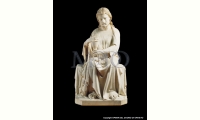 Eucharistic Christ and two angels (not shown in photo)
Eucharistic Christ and two angels (not shown in photo)
1347-1348
Marble; Christ, 75 cm., the two angels, 59 cm.
Provenance: Orvieto, cathedral
All three statues are on the whole well preserved. The head and neck of the angel on the left have been reattached. The wings of both angels were added in 1890 when the group was set in the lunette of the Porta del Corporale (the last door on the left side, facing the cathedra, generally not open), where it remained until 1985. The iconography of the Eucharistic Christ, who probably held a host in his right hand, relates to the relic of the Corporal, or holy altar cloth from the Miracle of Bolsena (1263) when drops of blood fell from the consecrated host on the altar cloth as the priest was saying mass. The statues were probably carved for an altar in the cathedral during the time when Andrea Pisano was in charge of the Orvieto construction yard. The figure of Christ can be attributed to Andrea Pisano, the two angels to Tommaso.
Coppo di Marcovaldo (?)
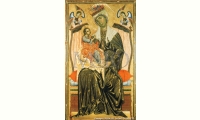 Enthroned Madonna and Child (Maestà) and two angels
Enthroned Madonna and Child (Maestà) and two angels
1265-1270
Tempera on wood with retouching in oil;; 222 x 134 cm.
Provenance: Orvieto, church of Santa Maria dei Servi
This large panel was cut along the bottom and partially repainted. The traditional attribution to the Florentine Coppo di Marcovaldo, based on its strong similarity with the Madonna del Bodone, painted by Coppo for the Servites of Siena in 1261 after he had been taken prisoner in the war between Florence and Siena, has been questioned. The Servites established themselves in Orvieto between 1265 and 1270. Both the Sienese and the Orvieto altarpiece bear witness to the fact that the Servants of Mary, in strong expansion, employed large format images to promote worship of the Virgin Mary.
Orvieto painter influenced by Simeone and Machilone
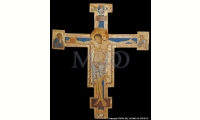 Crucifixion with the Suffering Christ (Christus patiens)
Crucifixion with the Suffering Christ (Christus patiens)
Third quarter of 13th centuryTempera on wood; 170 x 138 cm.
Provenance: Orvieto, monastery of San Ludovico
The Christus patiens is an image of Christ on the cross, his eyes closed. The earlier image of Christ, known as Christus triumphans, showed Christ with his eyes open, looking at the observer and triumphing over his death.
Simeone and Machilone (?)
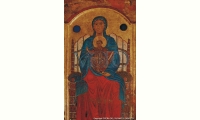 Madonna Enthroned and Child
Madonna Enthroned and Child
Mid-13th century
Tempera on wood; 75 x 50 cm.
Provenance: Orvieto, Confraternita del Carmine
This icon is one of the oldest panel paintings conserved in Orvieto. On the whole it is in fair condition, with the exception of the lower part where much of the paint has flaked off. The patterning of the stylized drapery and the frontal pose are typically Byzantine, with the Christ Child shown as a miniature adult. Only later (compare Gentile da Fabriano's fresco in the right (left) aisle near the entrance door did He become a real baby. To be noted the two beautiful blue glass disks (perhaps the sun and moon or with inscriptions) on either side of Mary's head.
It is traditionally attributed to Simeone and Machilone, painters from Spoleto, who were active in Umbria and the Marche around the middle of the thirteenth century.
Room 2
Sienese Master Cabinetmakers
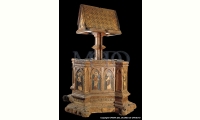 Lectern and fragments of the cathedral choir stalls
Lectern and fragments of the cathedral choir stalls
circa 1330 - ca. 1370
Wood, carved and intarsia
Provenance: Orvieto, cathedral,
The choir stalls in the cathedral of Orvieto are unique in their early date and in the complexity of the figured intarsias or inlays. While initially begun in 1330, work continued for about forty years and documents report various additions in the course of the fifteenth century. The choir stalls were located at the crossing till 1537 when Pope Paul III had them moved into the tribune or chancel.
Just what they originally looked like is debatable since their aspect was modified when they were moved and subsequently altered. Many parts were replaced with copies in the restorations of 1859, with the originals ending up in the Museo dell'Opera.
The complex, made by a group of Sienese master cabinetmakers, was probably begun when Lorenzo Maitani was in charge of the cathedral construction yard (1310-1330). Who the original designer was, and whether he also made the cartoons for the intarsia figures, remains problematical. It may have been Maitani, or possibly Giovanni Ammannati or Nicola di Nuto.
Among the most spectacular parts are the imposing gable with the Coronation of Mary - probably dating to the third quarter of the fourteenth century – which was located over the entrance to the choir stalls and the lectern with the twelve Apostles on the base. They differ in style and were therefore probably made by different artisans. Time and wood borers have damaged the carved parts of the lectern.
Simone Martini (Siena ca. 1284/1290 - Avignon 1344)
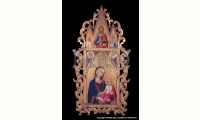 Virgin and Child with angels (central compartment of a polyptych)
Virgin and Child with angels (central compartment of a polyptych)
circa 1322/1324
Tempera, gold and silver leaf on wood; 182.7 x 59.7 cm. (excluding the 17th-century frame)
Provenance: Orvieto, church of San Francesco
The panel was cut off at the bottom and perhaps along the sides. It was the central panel of a polyptych or multi-paneled altarpiece whose actual makeup is still uncertain. A Saint Catherine of Alexandria in Ottawa has been identified as one of the side panels. To be noted are the seraphim, the cherubim and the thrones, composing the first triad of the nine angelic hosts. This fine painting was made for the church of San Francesco by Simone Martini and his assistants in the first half of the 1320s, during which time the painter executed three polyptychs for three Orvieto churches.
Spinello Aretino (1346-1410)
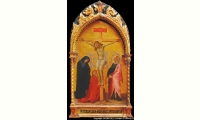 Christ on the Cross with the Virgin Mary, Mary Magdalene and Saint John the Evangelist
Christ on the Cross with the Virgin Mary, Mary Magdalene and Saint John the Evangelist
Last decade 14th century
Tempera and gold leaf on wood; 80x49 cm.
Provenance: Orvieto, City Hall, chapel of Saint Lucy
The figures seem to have been repainted in antiquity and two twisted columns inside on either side of the frame, which is original, are missing. The coats of arms of the city of Orvieto, an eagle and a rampant lion, are depicted on the bases of the two outer columns. Of particular interest is that while the partial inscription on the lower part, Ave Maria Gratia Plena: Ora (Hail Mary, Full of Grace: Pray.......), is usual for an Annunciation, here it has been incongruously used for a Crucifixion.
Third Orvieto master
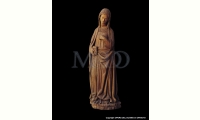 Annunciation
Annunciation
First two decades of the 14th century
Wood with traces of polychromy; Angel (not shown) h. 172 cm, Mary 170 cm.
Provenance: Orvieto, cathedral, choir stalls (?)
There were various ways in which Mary reacted to the Annunciation. Here she is shown accepting the angel's message and humbly pointing to herself as if to say "me?"
Simone Martini (Siena ca. 1284/1290 - Avignon 1344)
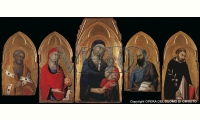 Virgin and Child with Saints (Mary Magdalene, Dominic, Peter and Paul)
Virgin and Child with Saints (Mary Magdalene, Dominic, Peter and Paul)
1320-1321
Signed and dated at the bottom of the central panel (inscription damaged):
...N DE SENIS ME PINXIT ...D M° CCC XX°...
Tempera, gold and silver leaf on wood; Virgin and Child, 112x63 cm., Mary Magdalene, 94x46 cm., Saint Dominic, 93x48.6 cm., Saint Peter, 86x48 cm., Saint Paul, 81x48,5 cm.
Provenance: Orvieto, church of San Domenico
These five panels are all that remain of a polyptych which must originally have had at least seven panels. Those at the sides have been cut off at the top and have been damaged along the lower edge. Even so the overall condition is good. The donor was the bishop Trasmondo Monaldeschi, shown kneeling in the panel with Mary Magdalene who is holding her attribute, the unguent jar. (Compare his relative size to the donors in the sixteenth-century painting of the Birth of the Virgin (1582) by Cesare Nebbia). The other saints can also be identified by their symbols: Dominic with the lily, (originally his position was on the far left), with the two apostles, Peter with the keys and Paul with the sword and wearing the stole crossed over his breast, symbol of his priesthood and of the yoke of Christ, flanking the central panel with the Madonna and Child. The Child holds a scroll with the words Ergo sum lux mundi. (I am the light of the world.) Since the inscription on the central panel is incomplete, the most likely proposals for the date seem to be 1320 or 1321. It has also been suggested that Lippo Memmi, Simone's brother-in-law, collaborated on this extraordinary painting, which is similar to the polyptych by Simone Martini in the Isabel Gardner Museum in Boston.
Pietro di Puccio (attr.)
Saint John the Baptist, donor and a prophet (?)
Last decade of 14th century.
Detached fresco; 230 x 110 cm.
Circle of Pietro di Puccio
Saint Romualdo
14th/15th century
Detached fresco; 208 x 110 cm.
Provenance: Orvieto, convent of San Domenico
Bartolomeo da Miranda
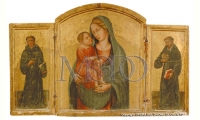 Madonna and Child between the Blessed Tommaso Corsini and Bonaventura Bonaccorti
Madonna and Child between the Blessed Tommaso Corsini and Bonaventura Bonaccorti
Mid 15th century
Tabernacle with wings
Tempera and gold leaf on wood: central panel. 54 x 47 cm. ; side panels, 44 x 23 cm.
Provenance: Orvieto, bishop's palace, formerly in the confraternity of San Michele Arcangelo
Luca Signorelli
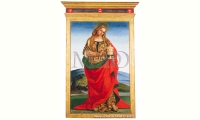 Saint Mary Magdalene
Saint Mary Magdalene
1504
Tempera on wood; 178x117 cm.
Inscriptions:
- below: ·CONSERVAT·PA·PACIS·CONSERVATRICI·EX·SE·CONSVLTO·M·D·IIII·
- on the upper frame, between the coats of arms of the City of Orvieto: ·CECCARELLUS·DE·ADVIDVTIS / ET·RVFINVS·ANTONII·
Provenance: Orvieto, cathedral, chapel of Mary Magdalene in the Cappella Nuova
This painting was commissioned by the city of Orvieto - "Dedicated by the Conservatori della Pace to she who keeps the peace". She holds her traditional attribute, the unguent jar, a sign of resurrection. The red and green of her cloak symbolize respectively love and repentance. An altar dedicated to her was installed in the Cappella Nuova, opposite the one to Saints Faustino and Pietro Parenzo. In 1653 the painting was removed for the construction of a choir loft. In 1723-24 Mary Magdalene's small chapel was completely redone in Baroque form. A preparatory drawing with a few variations with respect to this painting is in the Louvre. Most of the figure is by Signorelli himself, while the landscape is of inferior quality and was the work of his workshop.
Workshop of Pietro di Nicola da Orvieto
Madonna and Child, Saints Anthony Abbot and Bernardino of Siena
After 1450
Detached fresco; 105 x 200 cm.
Provenance: Orvieto, complex of San Martino ai Servi.
Painter in the manner of Perugino
Saints Peter and Paul
Late 15th – early 16th century (?)
Tempera on wood; each 125 x 39 cm.
Painter in the manner of Pinturicchio
Saint Nicholas
After 1495
Tempera on wood; 163 x 60 cm.
Saint Nicholas is holding a book and three golden balls, which legend has it that he threw over a wall into the home of three girls who had no dowry. He is also clothed as a bishop with cope and crozier.
Florence (?)
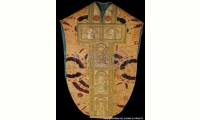 Chasuble
Chasuble
1460-1480
Pile on pile velvet and ciselé voided velvet, weft float and bouclè 83 x 164 cm.; size of repeat: 85 x 58.4 cm.
The decorative bands known as orphreys are embroidered in gold thread and polychrome silk in the or nué technique, split stitch, satin stitch, rush stitch.
Provenance: Orvieto, Cathedral
Florence (?)
Tunicle
1460-1480
Embroidered pile on pile velvet and ciselé voided velvet, weft float and bouclè.
160 x 145 cm.; size of repeat: 85 x 58.4 cm.
Orphrey (ornamental embroidered band) embroidered in gold thread and polychrome silk in the or nué or shaded gold technique, (gilt strip wrapped around a silk thread core), split stitch, satin stitch, rush stitch
Provenance: Orvieto, Cathedral
The chasuble and the tunicle are part of the so-called "Vanzi vestments", which also include a dalmatic, two stoles and four maniples. The chasuble, the dalmatic and the tunicle were worn by Cardinal Sebastiano Vanzi in 1563 during the services of the Council of Trent, but they were certainly made earlier. The coats of arms of the Opera and the images of the patron saints of the cathedral of Orvieto on the chasuble bear witness to the fact that it was specially made for the Orvieto cathedral. The embroidery dates to the last quarter of the fifteenth century and is based on designs by contemporary Florentine painters, identified alternatively as Bartolomeo di Giovanni, Sandro Botticelli and Luca Signorelli.
Painter in the manner of Titian
Venus gives Psyche the vase to fill in the Underworld
Second half 16th century
Oil on panel; 98x104 cm.
Provenance: Orvieto, Ronchini collection (?)
Venus, jealous of Psyche's beauty, gave her three tasks to fulfill, of which this was the last – to go to the Underworld and bring back a vase filled with Persephone's beauty. This picture closely resembles a painting attributed to Padovanino in the Palazzo Durazzo Pallavinci in Genoa. It could correspond to a painting of Pandora donated by Luigi Ronchini in 1884.
Circle of Cesare Nebbia
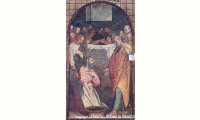 Christ Washing the Feet of the Disciples
Christ Washing the Feet of the Disciples
16th/17th century
Oil on canvas; 193 x 110 cm.
Originally in the cathedral of Orvieto – right side wall near the counterfacade
Restoration: Maura Borrelli, 2003
Workshop of Ippolito Scalza
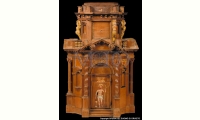 Tabernacle
Tabernacle
Early 17th century
Polychromed wood; h. 130 cm.
Provenance: Orvieto (environs), church of San Lorenzo in Vineis
This large wooden tabernacle is not complete. Meant to house the hosts, it was conceived of in the form of a central plan building in late Mannerist style and is to be seen in relation with the wooden Eucharistic tabernacle carved by Ippolito Scalza between 1558 and 1560 to a design by Raffaello da Montelupo. Scalza was head of the cathedral workshop from 1567 to his death in 1617.
Cesare Nebbia (Orvieto circa 1536 - 1614)
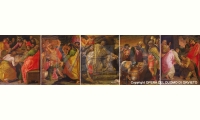 Prophets; Sibyls; The Fall of Manna; Sacrifice of Isaac; The Prodigal Son; Meeting of Abraham and Melchizedek; The Last Supper
Prophets; Sibyls; The Fall of Manna; Sacrifice of Isaac; The Prodigal Son; Meeting of Abraham and Melchizedek; The Last Supper
1563-1564
Oil on canvas; the three Prophets and the three Sibyls, 22 x 29 cm.; scenes from the Old Testament, 46 x 36 cm.
Provenance: Orvieto, Cathedral, sacramental tabernacle of the high altar
In the Opera since 1692
The eleven canvases were part of the large gilded wood tabernacle or container for the blessed sacrament, designed by Raffaello da Montelupo in February 1558 and carved by Ippolito Scalza before the end of 1560. It was one of the first tabernacles to be made after the Tridentine Reform and was probably taken as model by Vasari for the one in Santa Croce in Florence, also in the form of a small temple. The subjects allude to themes of the Incarnation and the Eucharist. The only figure among those of the prophets that can be identified with certainty is the Cumaean Sibyl. This was Nebbia's first work as an independent painter for the cathedral of his city. The style reveals influences both of Girolamo Muziano – his teacher – and of Taddeo Zuccari, both already working in the construction yard.
Circle of Cesare Nebbia
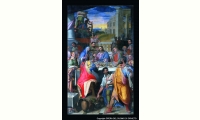 Last Supper
Last Supper
16th/17th century
Oil on canvas; 256 x 153 cm.
Provenance: Orvieto – Cathedral – right side wall near the counterfacade
Restoration: Maura Borrelli, 2003
Here as in other versions of the Last Supper, the hand gestures are of utmost importance.
Orvietan painter (?)
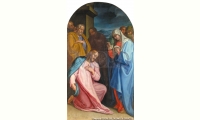 The Virgin Mary Blessing Christ
The Virgin Mary Blessing Christ
16th/17th century
Oil on canvas; 208 x 118 cm.
Provenance: Orvieto - Cathedral – right side wall near the counterfacade
Restoration: Maura Borrelli, 2003
Paintings of this subject, not mentioned in the Sacred Scriptures, are extremely rare.
Orvietan painter (?)
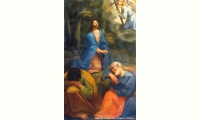 Jesus in the Garden of Olives
Jesus in the Garden of Olives
16th/17th century
Oil on canvas; 253 x 152 cm.
Provenance: Orvieto – Cathedral – right aisle near the counterfacade
Restoration: Maura Borrelli, 2003
Cesare Nebbia (Orvieto, ca. 1536 - 1614)
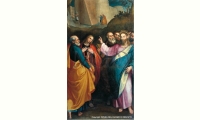 Jesus Sends Two Disciples to Jerusalem
Jesus Sends Two Disciples to Jerusalem
1611-12
Oil on canvas; 242 x 143 cm.
Provenance: Orvieto – Cathedral – right side wall near the counterfacade
Restoration: Maura Borrelli, 2003
Room 3
Girolamo Muziano (Brescia, 1532 - Rome, 1582)
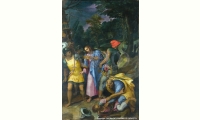 The Taking of Christ
The Taking of Christ
1584
Oil on canvas; 386 x 240 cm.
Provenance: Orvieto – Cathedral – right aisle – first chapel – altar of Saint Joseph and Saint Brendan Abbot
Restoration: Maura Borrelli, 2001
The last work painted by this artist from Brescia for the cathedral, it was also the first in the sequence of episodes of the Passion of Christ on the altars of the right aisle, while the altars in the left aisle were devoted to the Miracles. The naturalist setting, a distinctive element of Muziano's style, softens the dramatic tension of the scene in the foreground and envelops the large figures in a muted chiaroscuro. Christ is being arrested by the Roman soldiers and Peter in the foreground is cutting off the ear of one of them.
Girolamo Muziano (Brescia, 1532 - Rome, 1582)
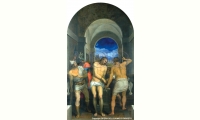 The Flagellation of Christ
The Flagellation of Christ
1575
Oil on canvas; 399 x 230 cm.
Provenance: Orvieto – Cathedral – right aisle – second chapel – altar of Saints Peter and Paul
Restoration: Maura Borrelli, 2001
The deep perspective seems to break through the wall, opening onto the sky and landscape. The figures of Christ and his torturers, on whom the dramatic action is concentrated, are projected into the foreground. Girolamo Muzio loved to experiment with this type of composition in which the naturalistic feeling of a Venetian type fuses with the Michelangiolesque monumentality of the figures.
Cesare Nebbia (Orvieto, ca. 1536 - 1614)
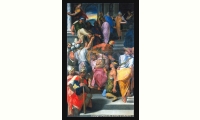 The Crowning with Thorns
The Crowning with Thorns
1575
Oil on canvas; 415 x 249 cm.
Provenance: Orvieto – Cathedral – right aisle – third chapel – altar of Saints Luke and Anne
Restoration: Maura Borrelli, 2001
Due to an error in the commissioning document, it was in precedence attributed to Girolamo Muziano. Comparison with the fresco of an analogous subject painted that same year by the artist for the Roman oratory of the Gonfalone, in which the same preparatory design was used, revealed the error. The fresco and the altarpiece, in which the pathos and dramatic composition that characterized the work of the Zuccaro brothers are evident, are almost identical. However on the left side of the Orvieto painting the portrait of a man wearing a hat, looking out at the observer, can possibly to be identified with the artist himself.
Girolamo Muziano (Brescia, 1532 - Rome, 1582)
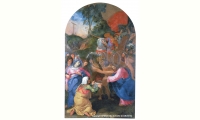 The Way to Calvary, Christ and Veronica
The Way to Calvary, Christ and Veronica
1557
Oil on canvas; 380 x 234 cm.
Provenance: Orvieto – Cathedral – right aisle – fourth chapel – altar of the Immaculate Conception
This is the second altarpiece painted by Muziano for the Opera. The prolonged presence of this artist when the Orvietan workshop got under way was unquestionably determining, for he also collaborated in the distribution of the pictorial decorations and in the planning of the stucco ornamentation. As Christ is on his way to be crucified, Veronica wipes the blood and sweat from his face with her veil, and the image of His face remains on the cloth.
Cesare Nebbia (Orvieto, ca. 1536 - 1614)
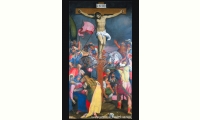 Crucifixion
Crucifixion
1573-74
Oil on canvas; 390 x 218 cm.
Provenance: Orvieto – Cathedral – right aisle – fifth chapel – altar of Saints Martin and Catherine
Restoration: Maura Borrelli, 2001
After his success with the first altarpiece with the Wedding at Cana, in the course of the 1570s Nebbia received a series of new commissions from the Soprastanti. In 1572 he did the frescoes of the fourth chapel on the right, then the altarpiece of the Crucifixion, and in the following year the Crowning with Thorns for the third chapel on the right, for which he also did the fresco decoration.
It has recently been shown through an analysis of some of the preparatory drawings for the Crucifixion that the artist was concentrating on a search for formal solutions in an attempt to merge the monumentality of Muziano with the dramatic dynamics of Taddeo Zuccaro in his figures. This experimentation resulted in a densely crowded composition that lacked in depth.
Nebbia has included all the customary scenes of the Crucifixion, with Mary fainting and supported by Mary Magdalene on the left, the soldiers throwing dice for the cloak of Jesus, the soldier piercing Christ's side with his lance.
Cesare Nebbia (Orvieto, ca. 1536 - 1614)
 The Wedding at Cana
The Wedding at Cana
1569-72
Oil on canvas; 405 x 246 cm.
Provenance: Orvieto – Cathedral – left aisle – first chapel – altar of Saints Jerome and Gregory the Great
Restoration: Maura Borrelli, 2001
This is the first important altarpiece commissioned from Cesare Nebbia, who had previously worked for the Opera del Duomo on the paintings for the tabernacle of the Sacrament and the frescoes of the first chapel on the left. The artist had requested this commission from the Soprastanti or commissioners more than once, first referring to his Orvietan origins, then affirming that he would be able to paint a work "much more beautiful than that of M. Nicolao [Circignani]", who had recently finished the panel with the Pool of Bethesda. On February 15, 1567 Nebbia obtained the long awaited commission and completed a first version in June 1568. It was damaged in a fall and was replaced by the one now here in 1572.
The work falls into a period of the artist's maturity. After his training next to Girolamo Muziano, he was influenced by Taddeo and Federico Zuccari, in particular in the composition and graphic clarity of the figures.
In the foreground the servants are pouring the water that has been transformed into wine while to be noted on the table is a round of cheese and a salt cellar.
Niccolò Circignani known as il Pomarancio
(Pomarance/Pisa, ca. 1517-24 - Città della Pieve/Perugia, after November 1597)
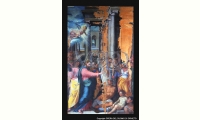 Pool of Bethesda (Jesus heals the Paralytic Man)
Pool of Bethesda (Jesus heals the Paralytic Man)
1565
Oil on wood; 410 x 249 cm.
Provenance: Cathedral – left aisle – third chapel
Restoration: Cooperativa C.B.C., 1993 e 2006
The panel is damaged and portions of the paint have flaked off.
After completing the fresco decoration of the chapel, commissioned in 1565 after Arrigo Fiammingo had renounced, Circignani was also charged with painting the altarpiece.
The work depicts, in the traditional iconography, the episode from the Gospel of St. John. In the foreground the paralytic man is on the ground waiting to be helped to be the first to go into the therapeutic pool after the miraculous arrival of the archangel Raphael, shown above left. Christ is standing next to him and stretching out his hand to heal him.
There are evident references to the paintings of the Sienese Mannerist painter Beccafumi (ca. 1486 – 1551).
Girolamo Muziano (Brescia, 1532 - Rome, 1582)
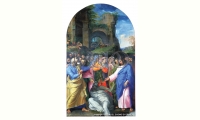 Resurrection of Lazarus
Resurrection of Lazarus
1556
Oil on canvas; 380 x 234 cm.
Provenance: Orvieto – Cathedral – left aisle – fourth chapel -
Restoration: Maura Borrelli, 2001
Girolamo Muziano was the first of the "foreign" artists engaged by the Opera to carry on the complex project of decoration of the side aisles of the cathedral. Raffaello da Montelupo, capomastro of the Orvieto fabbrica, had recommended the Brescian artist after his success with the altarpiece of the Resurrection of Lazarus painted in 1555 for Cardinal Colonna and originally in the church of Santa Maria Maggiore in Rome – now in the Vatican Pinacoteca.
Cesare Nebbia (Orvieto, 1536 circa - 1614)
The Birth of the Virgin
1582
Oil on canvas; 467 x 280 cm.
Provenance: Orvieto – Cathedral – counter facade – right side
Restoration: Maura Borrelli, 2001
"Per darli nuova della tavola del S.or Sforza Monaldeschi, io l'ò abbozzata tutta di chiaroscuro et ò speranza di farmi onore. L'ò mostra a parecchi galantomini, e a tutti è piaciuta". ("To furnish you with the latest on the panel of S.or Sforza Monaldeschi, I have sketched it all in chiaroscuro and hope to do myself honor. I have shown it to several gentlemen, and they all liked it.) In 1582, from Rome, Cesare Nebbia reported to the Soprastanti dell'Opera with regards to the painting commissioned by Sforza Monaldeschi for the family altar near the counterfacade of the cathedral. The work, of a Marian subject, was extraneous to the cycle of the Passion and Miracles of Christ illustrated in the side aisles. In this well-balanced composition the monumental and harmonious figures move in a realistic domestic setting that alludes to the Orvieto residence of the patrons, Sforza and Deianira Baglioni portrayed below together with their daughter. In the foreground the women are preparing the bath for the newborn child, while in the background, on the right, soup and a chicken are being prepared for the new mother, to whom two doves are also brought, as an offering for the temple.
The painting dates to the zenith of the artist's professional career. He was prevalently working in Rome for Pope Sixtus V and was highly successful. Various other versions of the subject are known, some in the area of Orvieto, others in Rome including the painting in the church of San Silvestro at the Quirinale.
Giovanni Lanfranco (1582-1647)
Coronation of the Virgin
1615
Oil on canvas; 250 x 150 cm. including the frame
Provenance: Orvieto, church of the Carmine, Marescotti chapel
The painting was originally in the Marescotti chapel in the Orvietan church of the Carmine. It was painted in 1615, and was closely connected to the Bongiovanni Altarpiece, created a year later for the Bongiovanni chapel in Sant'Agostino in Rome. There is a preparatory drawing for the Orvieto painting, with a few variations, in the Uffizi. When it was decided to replace the mosaic of the central gable in 1713, Lodovico Mazzanti was charged with creating the cartoon for the new mosaic, a copy of Lanfranco's painting. The mosaic of the Virgin Crowned is on exhibit across the room.
Lodovico Mazzanti (1676-1775)
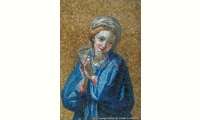 The Virgin Crowned (fragment)
The Virgin Crowned (fragment)
1713-1714
Mosaic in glass and stone tesserae; 92x73 cm.
Provenance: Orvieto, facade of the cathedral, central pediment
In 1713 it was decided to replace the mosaic with the Resurrection of Christ on the central gable of the facade of the cathedral with a Coronation of the Virgin. Lodovico Mazzanti was commissioned to make a reproduction (in scale) of Giovanni Lanfranco's altarpiece in the church of the Carmine. The tesserae of the new mosaic however soon began to detach and in 1724 reparations were necessary. It was definitely replaced in 1842 by a mosaic of the same subject, but this time it was based on a fifteenth-century work by the Sienese painter Sano di Pietro.



